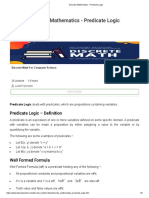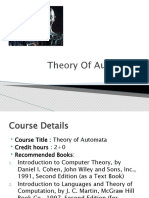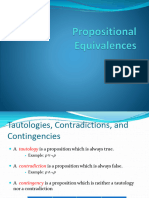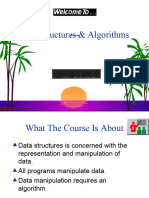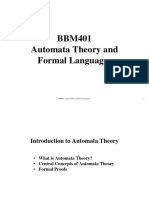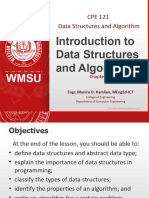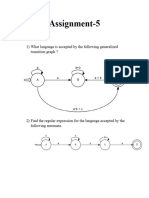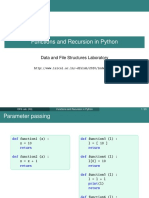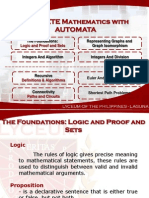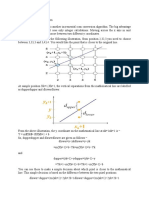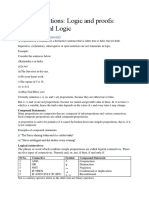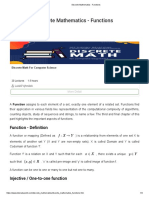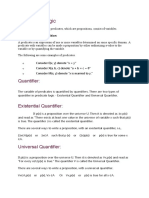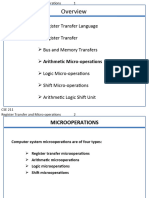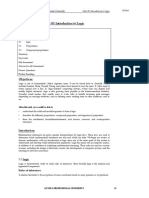0 ratings0% found this document useful (0 votes)
130 views28 pagesPropositional Logic
Uploaded by
Abhinay YadavCopyright
© © All Rights Reserved
We take content rights seriously. If you suspect this is your content, claim it here.
Available Formats
Download as PDF or read online on Scribd
0 ratings0% found this document useful (0 votes)
130 views28 pagesPropositional Logic
Uploaded by
Abhinay YadavCopyright
© © All Rights Reserved
We take content rights seriously. If you suspect this is your content, claim it here.
Available Formats
Download as PDF or read online on Scribd
You are on page 1/ 28
Propositional Logic
Syllabus
Definition, Statements & Notatio,
Tables, Well-formed Formulas,
Implications, Examples
”, Truth Values,
Tautologies, Eng Statement Formulas & Truth
lence of Formulas, Duality Law, Tautological
Contents
4.1 Logic
42. Statements (or Propositions)
43 Open Statement
44. Truth Value of a Statement
45 Truth Table
4.6 Logical Connectives
47 Tautology
48 Contradiction
4.9 Precedence Rule
4.10 Logical Equivalence
4.11 Normal Forms
a9)
Proposition)
Discrete
eee tee
ma Logic
(or oi is analysis of language, which consists of sig Lo
axioms) which we can use to draw valid conclusions:
my Statements (or Propositions)
Statements are kinds of sentences which we have to use to convey our thoughts b
others. A sentence is a statement or proposition if it is possible to say whether wha
conveyed by the sentence is true or false.
gic is a set of rules
pon, A Sentence of which itis meaningful, to 58, whether it is, te or false batty)
‘oth is called a statement or proposition.
We denote statements by letters p, q, 1) §-
Examples
1. Pune is capital of India
2. Mars is a planet.
3.9 > 13.
4y+8=12
5. 6 € (1, 2, 3, 4}
6.xEA.
7. There are 12 months in a year.
Examples (2' and (7) are true statements.
Examples‘1', 3:, ©) are false statements. In example 4, if we write 4 in place of y,
it becomes a true sentence and if y is not 4 then it is a false sentence. Similarly in \6) we
cannot say whether this sentence is true or not unless we are told what are the elements
of A.
Thus only those sentences are statements about which we can say whether these ar
true or false.
Definition
A statement is a declarative sentence with a definite truth value.
Hence (1), (2 ®, @ are statements.
> is not a statement since its truth value depends on the value of y- If y is 4 the
sentence is true, if y # 4 then the sentence is false.
‘Also@) is not a statement since its truth value depends on set A, if A = fx ¥ #4
then © is true but if A = (1, 2, 3, 4} then ©6/'is false.
TECHNICAL PUBLICATIONS” - An up thrust for knowledge
ye Mathematics yu
“ae = Propositional Logic
Open Statement
xample @ above if w mee
Ine ee ug ae oun va nf = 4, it becomes a true statement, if we take value of
yates atements are open statements. Thus if a mathematical
sntence is neither true nor false it is called open senten
4 ce.
pefinition
‘An open statement is a sentence that contains one or more variables such that when
contain values are substituted for the variables, we get statements
examples
1xt7=9
2ax+2>8
3.xeA
I Truth Value of a Statement
Statement has a definite truth value which is either true or false. True values are
denoted by (I) and false values are denoted by (F).
EI Truth Table
‘A table giving all possible truth values of a statement is called truth table.
|Exercise 4.1
| 1. Which of the following statements are true and which are false ?
a9<22
») 2 is a prime number.
) 41 is a composite number.
@)2+5=34+9
. What type of the sentence is
x+8=17?
For what value of x following sentences will become true statements ?
a)3x+9=15 b)xt+6=8
ox+1>5 djx+2<8
¢) Sx 2 25 ff) 5x $25
Which of the following open statement
a)x+4=6 whenx=2
c)x+5#8 whenx=3
) 3x + Sy = 11 when x = 0,
= ee
TECHNICAL PUBLICATIONS? An up trust for knowledge
its are true ?
p) x +44 6when x =2
d) 2x + 4y = 14 when x=1y=3
ya2 Set 2, x) when x =5
S Define the Sollowing and illustrate each by an example.
a) Statement
») Open statement
NSWers
fe) True b) True ¢) False) False
Bee Open, statement.
Se a)ixa2 b)x=2 a) x25
Dx<6orx<5 x25 fx<5
a) True b) False) False
4) True e) False) True.
na Logical Connectives
Every statement must be either true or false but not both.
If 3 two or more statements, they can be combined to produce a
These statements are called compound statements.
To combine statements we use following symbols.
Ea Conjunction (‘\' or ‘and')
If p and q are Statements, the compound statement ‘pA q' is 'P and q' and is
Conjunction q’ or 'p meet q- 4
‘A’ denotes ‘and’ and is known as conjunction.
Examples
1. Let us consider
P : Shalaka is in senior KG,
4: Shalaka likes drawing,
then p A q is the statement
Shalaka is in senior K.G. and likes drawing.
Definition
NEW: stay
snematics i
_ agate Mathomne 4-5 Propositional Logic
pi3>2
q:9 is an odd number,
then p 4 q is the statement
3 >2and 9 is an odd number,
p : 28 is divisible by 5.
q : Shalaka likes swimming,
then p 4 q is the statement
25 is divisible by 5 and Shalaka likes swimming,
Remark
i, If there is no connection between two statements still we can combine them in
logic.
ii, ‘But’ and 'while’ are treated as equivalent words to ‘and’.
iii, Conjunction is a binary connective as in conjunction we need atleast two
statements to combine.]
1. If p is true and q is true then p , q means the resulting statement is true.
2. If p is false and q is false then p » q is false.
3, If pis false and q is true then p a q is false.
4. If p is true and q is false then p A q is false.
Truth table for p aq
P\qis true only when both are true otherwise false.
145.2] Disjunction ('v’ or ‘or')
When two or more statements are combined by the word ‘or’, the compound
Statement ig as disenedeah
The symbol 'p v q' is read as 'p or q' or ‘p disjunction q' or 'p join q).
TECHNICAL PUBLICATIONS? - An up thrust fr knowiedge
4-6
Discrete Mathematics
Examples
Let us consider the statements
1. P: I will purchase a dress
4: Lwill purchase a book,
then p v q is the statement he
I will purchase a dress or I will purchase
2.
P : a is equal to 5.
4: b is equal to 7,
then p v q is the statement
a is equal to 5 or b is equal to 7.
1. If pis true and q is true,
then p v q is true.
2. If p is true and q is false,
then p v q is true.
3. If p is false and q is true,
then p v q is true.
4. If p is false and q is false,
then p v q is false.
Truth table for p vq
Remark
- Freee teas citer & tue or gis tue or bth p and q aw te
is false if both p and q are false, ae
fi, Disjunction is a binary connective
4H The exclusive disjunction of exclusive ‘OR Propositi
2 Soe Siher pls te or qs tue bat bother
Be AP a ta oe uaa ge )
SEN
rete Mathematics 4-7 Propositional Logic
jv, Inclusive disjunction or inclusive ‘OR’ of two propositions p and q is the
statement. ‘Either p is true or q is true or both true: ie. pyq
truth table for p®q [exclusive ‘OR']
asc ee a ee ao
j
| P L q Pea |
| ee eae F
| 2 eee aes
a a
ree
LE eg ee
example for exclusive ‘OR’
| shall go for walk or I shall watch TV. Here the connective ‘or’ is used in exclusive
sense.
ie, Either one or the other is possible at a time but both are not possible.
[EGEI Negation (~)
Let p be any statement then negation of p is denoted by '~p' (or ) is read as ‘not p'.
Ifp is true then ~ p is false.
If p is false then ~ p is true.
Truth table
~ p is a unary connective as only one statement is required to form negation.
Examples
1. If p is the statement ‘Ram is intelligent boy’,
then ~ p is the statement.
‘Ram is not intelligent boy.’
or 'It is not the case that Ram is intelligent boy.’
2. If p is the statement 'I like to read’,
then ~ p is the statement.
‘T don't like to read’
or It is not the case that I like to read.
TECHNICAL PUBLICATIONS” An up thrust for knowledge
Discrete Mathematics
ERX conditional connectives (if -
_Consider the proposition ‘If Akash ge
will get admission for engineering course:
C in 12" examinati
ts 90 % or more ™ then i,
We can write this statement as
‘If p then q’
P: Akash gets 90 % or more in 12'" examination.
q : Akash will get admission for engineering course.
This is an example of implication of q by P-
Definition
Let p and q be two propositions, then the statement
‘if p then q' is denoted by p — q (p implies q) or 'p is sufficient for q' or 'p only if
or 'q if p' or 'q is necessary for p’.
P is known as hypothesis or antecedent and q is known as conclusion or consequent,
A statement or Proposition of the form p > 4 is called a conditional statement or
conditional proposition.
Example
‘If a is in S, then a is in € (complex number) the hypothesis is a € % and the
conclusion is a €.
This can be expressed as ae R > ac
1) If p is true, q is true then
P qis true.
2) If p is true, q is false then
Pq is false.
3) If p is false, q is true then
Pp qis true.
4) If p is false, q is false then
Pp qis true.
Truth table for p > q
pscrete Mathematios 4-9 Propositional Logic
a -
SS
-———++—_+
I F T Sy ae i
Seem se |
Examples for conditional connectives
1. p: The function is differentiable.
q: The function is continuous,
If p then q
ie pq
or p is sufficient for q.
2. p: Weather is good.
q: Match will take place.
If weather is good then the match will take place.
p>q
3p: (E+) isa field.
q: G, +, is an integral domain.
1: (R, +,) is a ring.
Oe
Every field is an integral domain.
@i) por
Every field is a ring.
(i) q>r
Every integral domain is a ring.
Remark
If p, then q
qifp
P only if q,
P is sufficient for q
q is necessary for p
are all equivalent to the statement.
Pq.
a TECHNICAL PUBLICATIONS®- Anup thst or Iowiedge
Proposit
Discrete Mathematics 4:10 St Lope
Remark
1. Converse of p > q is q — p.
2. Inverse of p + q is ~ p> ~ 4
i valence)
EXE Biconditional (or Double Implication or Equiv )
" ‘ alled bi i
If p and q are two propositions, then 'p > q' and 'q > P 1S & conditional o,
double implication. It is written as
eal
and it is known as
'p if and only if q’ : awe
‘if and only if is shortened as ‘iff’. © is also known as ‘implies and is implied’,
We also say ‘p is necessary and sufficient for q’.
P © q is true when truth values of p and q are same, ie. either both true or both
false and false otherwise.
Truth table for po q
Bere) a oP PiLQS
@>9A@>p)
Ze
Biss
F
F
T
Example
Ina triangle ABC,
p:2C=90°
q: (AC)? +(BC)? = (AB)?
If p then q
peoe od aD [By Pythagoras theorem]
Also if q then p
ieq>p ~ @) [lf (AC)? +(BC)? =(AB)2 then ZC = 904)
From equations (1) and (2),
Propositional Logic
piscrete Mathematics
[EI Contrapositive of an Implication
‘The implication ~ q — ~ p is called the contrapositive of the implication p > q-
ie. implication p — q and ~ q ~~ p are the contrapositive of each other.
Example
i) If in a triangle ABC, 2 A = 90° then (AB)? +(AC)? =(BC)?.
ii) If in a triangle ABC, (AB)? +(AC)? # (BC)? then 2 A 490°,
‘Above two implications are the contrapositive of each other.
1) If p is true, q is true then p — q is true and ~ q is false, ~ p is false
but ~ q> ~ pis true.
2) If p is true and q is false then p — q is false, ~ q is true and ~ p is false
but ~q > ~ pis false.
3) If p is false, q is true, then p + q is true, ~ q is false, ~ p is true
but ~ q— ~ pis true.
4) If p is false, q is false, then p — q is true, ~ q is true, ~ p is true
and ~ q— ~ pis true.
The following table gives the truth value of the implications p > q and ~ q > ~ p.
Truth table for p > q and ~q >~p
4-2
+ i) ps: There are many clouds in the a
q: It rain.
“ PA~q
ii) p: I will get first class.
q: I study well.
1: Score above 80 in mathematics.
“Pe (qa
iii) p : Computers are cheap.
q : Softwares are costly.
= PA
iv) p : It is very hot.
q: It is very humid.
1: Ramesh is having heart problem.
“ @AQvr
v) p : In small restaurant food is good.
q : Service is poor.
“Pad
vi) p :I finish my submission before 5.00 pm.
q : It is very hot.
r: I will go.
s : I will play a game of hockey.
2 (pa~q) > (ras)
TECINCAL PUBLCATON® Ano at br ow
scrote Mathematics
° 2 Propositional Logic
solution: i) PAq
ii) (PAA > p)
iii) pO~q
iv) (~PA~Q>~r
v)~pa~qa~r.
GENIE rr te conti, cn :
» converse, ini
conditional statement given below : werse and negation forms of the
‘if x is rational, then x is real,’
Solution: Let p : x is rational,
q: x is real.
Symbolic form : p > q
Contrapositive : (~ q > ~ p)
If x is not real, then x is not rational.
Converse : (q > p)
If x is real then x is rational.
Inverse : (~ p > ~ q)
If x is not rational, then x is not real.
Negation : ~ (p — q)
22650)
«eae
sia
(EERE) press the conirapostioe,
. if3 t
Contrapositive : (~ r > ~ (p49)
ie. ~r—(~pv~q)
ie. it sin % +5 then 326 or 1+1#2
= TECHNICAL PUBLICATIONS” - An up thrust for knowledge
Pro
ee
|
| Exercise 4.2
ie. if 32bor1+1+#2 then sin
Converse : r 5 (p aq)
ie. if sin $= then 3 ~ 1
ie (~pv~q)o-r
1. If ’p’ stands for the statement 'I read book’ and ‘q' stands for 'T go for swimming’, trang,
the following in words
aprq Dpva
o~pvq a pa(~q
If ‘p’ stands for the statement ‘Ramesh is a player’ and ‘q” stands for ‘Mohan is q strong
boy’, translate the following in words :
apaq D~paq
pat-q) d)~pa-q
D-prag fl-~perq
pr>~q
If ‘p’ stands for ‘I run fast’ and ‘q’ stands for ‘I shall win’, express the following
symbolically :
a) I do not run fast.
5) If I run fast, I shall win.
©) I run fast or I shall not win.
4) I run fast and 1 shall win.
¢) I neither run fast nor I shall win.
f) I shall win if and only if I run fast.
4 If p stands for ‘it is cold’ and q stands for ‘it is raining’ translate the following into
symbols :
4) It is cold or it is raining.
b) It is cold and it is raining.
©) It is cold but it is not raining.
4) It is not cold but it is raining.
0) If it is not cold then it is not raining. peal
‘fi Sufficient condition for rain is that itis cold.
g) A necessary condition for raining is that it be cold
Wy A necessary and sufficient condition for raining is that it be cold.
wv
»
TECHNICAL PUBLCATONS. An op mt er nounage
pisorote Mathematics 4-15 Propositional Logic
‘Answers
1, a) read book and I go for swimming,
b) I read book or I go for swimming,
¢) Either I do not read book or I go for swimming.
d) I read book and I do not go for swimming.
2, _ a) Ramesh is a player and Mohan is a strong boy.
b) Ramesh is not a player and Mohan is a strong boy.
c) Ramesh is a player and Mohan is not a strong boy.
d) Neither Ramesh is a player nor Mohan is a strong boy.
e) This is not the case that Ramesh is a player and Mohan is a strong boy.
£) Ramesh is not a player if and only if Mohan is a strong boy.
g) If Ramesh is a player then Mohan is not a strong boy.
3 a)-P Piped
pv (~q) dpagq
e)~pa-q Nqop
4 apvq DPA
) pa(~q) d) (~p)aq
e-~p>-~q fq>p
8)P>4 py need
Tautology
A tautology is a proposition which is true for all truth values of its
sub-propositions.
In other words a proposition is a tautology if it is always true for all assignments of
truth values.
EE] contradiction
A proposition is a contradiction if it is always false for all assignments of truth
values.
Remark : A proposition which is neither a tautology nor a contradiction is called a
contingency.
carga renee anne
GENE sion tne i a feitaleey
"TECHNICAL PUBLICATIONS®- An up tus for knowledge
Discrete Mathematics
Solution ;
Since in p > p all the truth values are true (T),
EEEEOEES Show that p v (~ p) is a tautology.
hence p — P is a tautology.
Solution :
Since in p v (~ p), all the truth values are true (T), hence p v (~ p)
ha that ip a (ply a
Solution :
Hence ~ (p (~ p)) is a tautology.
Remark : p » (~ p) is a contradiction as all the truth values are false (F).
Tes istey
Example 4.8
Hence (p > q) © (~ p) vq isa tautology.
TECHNICAL PUBLICATIONS. Anup tua er nowoage
pee
piserete Mathematics ee sdciaiteee!
Construct truth table for (question 1 to question 5) to find if each of the
following is a tautology, contradiction or contingency.
10992) 7),
Solution : Consider the truth table,
q 5 P49) 059 Gon P5q>y PQ >~>) PIG>D>
ye @>9>0 >»)
T (* T tT T Ae T Salers wy a o
UF ae) F at D i z T
a AE |e F || F 1 sual
eiFl Ff len olen! Br ane
TOT ry T a T re
Flot |e ee ee a a
TOF| T T ol iw J Feuer
FOF. fe My T tT! ur eae T
In the last column all truth values are (T), hence
(p> >») > (P > 9) > (P 2) is a tautology.
2)((pvqa~P)>4
Solution: Consider the truth table.
Hence ((pvq) ~ p) > q is a tautology.
3) (P39 AG>01 9(P>)
Solution: Consider the truth table.
TECHNICAL PUBLICATIONS? - An up thrust for knowledge
Hence [(p— q) a (q 1)] + (p> 1) is a tautology:
4) (PAg A~(pvag)
Solution : Consider the truth table.
et See
Hence (pq) ~ (pv q) is a contradiction.
5) (p> 9) (qv ~p)
Solution : Consider the truth table.
E v-p (po@d—> @v~p) (©3906)
ie P q P op7a 4 avon) 559) Wee
2 ee
F
F
oe
T
Hence (p— q) © (qv ~ p) is a tautology.
CEERI ve proton p=) i te.
Solution :
Prise ce Pag ~@aq@
Bek ec Z stew ion
Baier apes eR gear
eet iwte ole eB, =
F F E
Hence pv ~ (pq) is a tautology.
TECHNICAL PUBLICATIONS. np tus or imowledgo
Discrete Mathematics
a: Soild, Propositional Logic
(EB) Precedence Rule
ee ae ity Operations on numbers, we realize the importance of BODMAS
ce ane se a ee ues calculating the value of an arithmetic expression, we
lue of the Bracketed part the ati
Be dition and subteatieneite ome cee ek apply of, division, multiplication,
Similarly while calculating the truth value of compound propositions involving more
than one connective, we have a similar convention which tell us which connective to
apply first
Suppose we did not have an order of preference and want to find the truth of ~ pv q-
Some may ‘consider the value of (~p)v q and some may consider ~(pvq). The truth
values can be different in these cases.
For example :
If p and q are both true, then (~ p) vq is true but ~ (pv q) is false. So, for the purpose
of unambiguity, we agree to such an order or rule.
The rule of precedence : The order of preference in which the connectives are
applied in a formula of propositions that has no brackets is
i)~
ii) A
iii) v and ®
iv) > and &
Remark :
1. 'v includes ‘exclusive or’ and ‘inclusive or’ both.
2. 'v' and '@' which are both third in order of preference. If both these appear in a
statement, we first apply the leftmost one. The same applies to the > and <>.
no Logical Equivalence
In mathematics, as in ordinary language, there can be several ways of saying the
same thing.
Definition
Two propositions A and B are logically equioalent if and only if they have the same truth
value for every choice of truth values of simple propositions involved in them.
We denote this fact by A = B.
In other words two propositions A and B are logically e
Aq Bis a tautology.
quivalent if and only if
TECHNICAL PUBLICATIONS? - An up thrust fr knowldge
'Y equivalent using truth tables
Prove that (p vq) \~ p =~ PA:
Solution : Consider the truth table.
P q ~P Pua
iS! eT T F E
aad F F Bi
F T T T
F F T F i
From the table, truth values of (p vq) ~ p and ~ pq are same for each choice of
P and q. Hence (p v q) 4 ~ p is equivalent to ~ p 0 q-
ie (Pvqa~p = ~paq
Prove that @>G>n)=(e>99047)
Solution : Consider truth table.
por pP>24@>) Pa > 59
cae ee
F F
me ae
E T
ae [Pees ee Te T
Te een
a T
T T
In last two columns, truth values are same for each choice of truth values of p,q
and r hence
P>@>*) = (P>q>(P>n)
or (P>(q>»)) = (Pq) > (pn)
Duality Law
Two formulas A and AY are said to be the duals of each other if either one can be
obtained from the other by replacing 's’ by \V and 'V’ by ‘s’. The connectives ‘a’ and V
are also called dual of each other.
TECHNICAL PUBLCATONS. An pat owe
piscrete Mathematics 4-21 Propositional Logic
Logical identities
4, DeMorgan's laws
i) ~(pv@ = (~pa~q)
ii) ~(PAq) = (~pv~q) [Dual of (i)]
2, Associative laws
i) pv(av2) = (pvqyvr
ii) PAAD) = (PAQ)ar {Dual of (i)]
3. Commutative laws
i) Pyq ™ qvp
ii) PAG = qap [Dual of (i)]
4. Idempotent laws
i) PVP =p)
ii) PAP =P [Dual of ()]
5, Double negation
~ CP) =e
6, Distributive laws
i) pv(qax) = (pyg)a (pv2)
ii) pA(qvr) = (pAqgv (par) [Dual of ()]
7. Absorption laws
i) Pv(PAq) = P
i) papva) =P Deal of
Logically equivalent
TECHNICAL PUBLICATIONS” - An up thrust for knowledge
Proposition
4-22 Logie
Solution: i) ~ (pvq) = ~pa-a
Consider the truth table. ae
~(pv@
Paw
From the table, truth values of ~ (pv q) and ~ p’~ q are same for each choice of
p and q. Hence
~(pvq) =~pa~q
a) ~(PAq) = ~py~q
Consider the table.
q Ss el pAq ~(PA@ —~Pvaq
F
a
T
a
From the table, truth values of ~ (pq) and (~ pv ~ q) are same for each choice of
pand q.
Hence ~(paq) = (~pv~q)
Smee Ee
ace
Solution :. i) pv(paq) =p
TECHNICAL PUBLICATIONS. An ptt orion
te Mathematics
ai 4-23 Propositional Logic
Dis
p. a PAq
ig T T
rr F F
b FE aa Bane F
eae ee
From the table, in last two columns, trut
truth val
each choice of p and q.. Hence values of pv(paq) and p are same for
Pv(PAq) = p
ii) pa(pya) =p
Consider the table.
mains
From the table, last two columns are identical, hence
PA(pvg) = P
Note : Proofs of remaining identities are left as an exercise to the students.
SERED es -
Solution: Consider the table.
P 2 — are Es - as
tae ee :
T Sea ee
F tie eee he
Hence ~ pv q and p—>q are logically equivalent.
TECHNICAL PUBLICATIONS” - An up thrust for knowledge
Discrete Mathematics “4 ——s =
pO & logically equivalent to (p>DAG p) also (P>9) Ag 5) @
logically equivalent to (~ pv q) a(~ 4 P)-
Solution : Consider the table.
Po 4 ~P ~a psa q rp Po@aca>p) Pod -~PYd “IVP CPvq,
Cavp
tl afeter| ot T tig) ae
T oF al T F T F 3 y z e
Fatal et Fe [era F oT ee
[Fler oa) T T T T a a T
From the table, t_t_______+
Pq = (~pvq)a(-~qvp)=(p> dA > P)
Normal Forms
In logic, with the help of truth table we can compare if two statements are
equivalent.
But when more statements or propositions are involved, then this method is not
practical.
[As if n propositions are involved, its truth values will be 2" ]
Hence, it is necessary to apply another method.
One method is to transform Sj andS3 to some standard form Sj and $5. Such that a
simple comparison of Sj and $3 should establish whether Si = S}.
The standard forms are called normal forms or canonical forms.
Disjunctive Normal Form [dnf]
Disjunctive normal form is a disjunction (V) of fundamental conjunctions (a) .
Now fundamental conjunctions (1) are conjunction of simple statements [i.e. joining
two statements by 'a].
fe. Pr, PAG ~PAG ~PA~q PA~p, qa~q, pa~q, ~ p are fundamental
conjunctions.
Hence disjunction of fundamental conjunctions are joining fundamental conjunction
by.
TECHNICAL PUBLICATIONS. tn up att in
Ne ee | ae
thematics p
pero ath 4-25 Propositional Logic
examples
1) (PADYPVGA~P)
2) (PAGADY(PAQ’AT) VP’ Agar)
3) (p'AQANV(PAQ)
4) (pagvl)
5) (pag (tag) v(~ rap)
Remark
qA~ 4 PA~P ate always false. Hence if a fundamental conjunction contains at least
one pair of (p and ~ p) or (q 4 ~ q) etc., it will be false.
Example
1, Obtain the dnf of the form
paip>q)
= pa(~ pvq) [as p>q = ~pval
= (pA~p)v (Pag) [Using distributive law]
= Fv(paq)
=(paq) dnf
Conjunctive Normal Form (cnf)
Conjunctive normal form is a conjunction (A) of fundamental disjunctions (v).
Now fundamental disjunctions (v) are disjunction of simple statements.
[ie. joining two statements by 'v]
Example
PYq, PY~q,~PVq, ~PV~ 4, ~ P, ~ % P, q, ete. are fundamental disjunctions.
"Hence conjunction of fundamental disjunctions are joining fundamental disjunction
by'a
Examples
1 (pvg)a (qvx)a (~ py~»)
2. pa(~qv~r)
3.(pvqv~1)a (pvg)a (- pvav~)
TECHNICAL PUBLICATIONS" - An up thrust for knowledge
4-26
Discrete Mathematics eae
Truth Table Method to Find dnf
v3 pi, P2”
Let p be a proposition containing variables P1
To find its dnf from the truth table:
Step 1 : Consider the true values (T) from P.
Step 2 : Form the conjunction ('4')
(Pi Apa A oA Pi Ae ABR A oA Pav
where if p; is true consider p; and
if py is false consider ~ Px
such a term is called minterm.
Step 3 : The disjunction of minterms is the anf of the given form.
Conjunctive normal forms and disjunctive normal forms (cnf and dnf)
Obtain conjunctive normal form of
D(-prnaer”
i) (RADY PAIAN,
Solution : i) (~ p> )a(P>
= (~(~p)vgaPvd
= (py@a(-pya) ent
ii) (paqy (pagan
= (pv(~ pagan)a av PAGAD)
. (py~p) apy awyn)a(ay-PAav dala)
= Tapa aipy) Aav-P)A@AaYD)
= (pyv@atpynaqy~p)a@acays) one
(QEEEERED Fired conjunctive normal form and disjunctive normal form for the
without using truth table.
(p>gag>P)
Solution: (p>q)A(q>P)
= (~pyq@a(-qvp) cnf
©) Pires Pky oe
Propositiongy len
Pn-
[As p> = ~pvq]
[As ~ = p=]
[Using left distributive law]
= ((~p)a(-avp))v(qa~qvp)) [Using distributive law]
= (~pa~a)v(~ Pap) v(qa~q)v(qap)
= (~pa~q)VFVFv(qap)
= (~pa~q)v(qnp) dnt
TECHNICAL PUBLICATIONS’ - An up thrust for knowledge
piscrote Mathematics 4-27 Propositional Logic
Obtain disjunctive normal form of
DPIDAC PaAQ)
i) PAP >) 4
Solution: i) (Pp q)A (~ pag)
= C PY A png) (p> = ~pval
= (PA pag)viqa~ pag) [Using distributive law]
=(GPA~p)agviqaqn~p) [By associative and commutative laws]
= (~ pq) v(qa~ p) anf [By idempotent law]
i) (pap? 9) > 4
= (PAC pyg)3q [p> q=~pval
(PA pyg))vq
= ~pv(-(~pvq)vq
= ~pv(pa~q)vq dnt
Obtain the conjunctive normal form fay of the following :
dp AG >9)
ii) ~ (pv g)o(paq)
Solution: i) pa (p> q)
= pa(- pvq) enf
i) ~(pvq) @ (PAQ)
= (pvav@aglal-(pagv~(pvgl
Po q=(- pyvga qvp)]
= [pva)vpagalc py~ av(~pr~q)]
= [Pvavp)A@vav DIAl(- py ~ qv ~ p)a(- pv~qv~ ql
= (PYQA(pYMA- pY~ QA PY~ 9)
= (pyqa(~pv~q) ent
— IPEQvn)>~P
— W(~3)>9> 4
Solution: Using truth table method, find dnf, which is logically equivalent a given
form.
TEGHNIGAL PUBLIGATIONS? - Anup tus fr howe
Discrete Mathematics “
= awe pov? Pe@vns.
4 r - >
T D T F T - a
a T F F Z 3
eee or
Rate TF See E F
a T iT T 0 F
F T Sa T T F
pea, F T on | ot
[aseciee | t L t
Consider only (I) from last column and choose corresponding ae a from p,q,
eg. for marked row (9), corresponding p is true q and r are false, 80 consider
(PAQ’Ar) oF (PA~qn~D)-
Similarly for other (T) values choose truth values from column of P, q t. Choose p ig
P is true otherwise p’ or ~ p if p is false.
Hence the logically equivalent form of
(POQvn)>~pP = (Pag ar)Vip’ GAY AGATIVP'AD AD)
v(p'aq’ar)
sane «2
(GAT) A= p9(~ pa~1)) by truth table method. — oe
Solution
r~po(~pr~n (p> qan)
ACP
P 4 © -Pp~r qarpoqar~P
bat) | fo
| |
malin fa
alalalal
Hence the logically equivalent form is
(PAGAN AgAr)V(p'Ag’ ar’)
TECHNICAL PUBLICATIONS. Anup het or
You might also like
- Subject:-Data Structure Using C 3 Semester A: G.H.Raisoni College of EngineeringNo ratings yetSubject:-Data Structure Using C 3 Semester A: G.H.Raisoni College of Engineering6 pages
- Web Technology-Lab-Manual III-II r22 Updated 24No ratings yetWeb Technology-Lab-Manual III-II r22 Updated 24114 pages
- Introduction To Data Structures & AlgorithmsNo ratings yetIntroduction To Data Structures & Algorithms62 pages
- BBM401 Automata Theory and Formal Languages 1No ratings yetBBM401 Automata Theory and Formal Languages 134 pages
- Terminologies and Special Types of GraphsNo ratings yetTerminologies and Special Types of Graphs5 pages
- Now It's Time For : Recurrence RelationsNo ratings yetNow It's Time For : Recurrence Relations30 pages
- CPE121 - Chapter01 - Introduction To Data Structures and AlgorithmNo ratings yetCPE121 - Chapter01 - Introduction To Data Structures and Algorithm24 pages
- DISCRETE Mathematics With Automata: The Foundations: Representing Graphs and Graph IsomorphismNo ratings yetDISCRETE Mathematics With Automata: The Foundations: Representing Graphs and Graph Isomorphism42 pages
- Fundamentals of Data Structures in C - , 2 - Ellis Horowitz, Sahni, Dinesh MehtaNo ratings yetFundamentals of Data Structures in C - , 2 - Ellis Horowitz, Sahni, Dinesh Mehta521 pages
- Data Structure Interview Questions: Applications of DSANo ratings yetData Structure Interview Questions: Applications of DSA7 pages
- Discrete Mathematics: Propositional EquivalenceNo ratings yetDiscrete Mathematics: Propositional Equivalence36 pages
- A116754499 - 33548 - 27 - 2025 - Academic Task Number 1 CAPITAL MARKET OPERATIONNo ratings yetA116754499 - 33548 - 27 - 2025 - Academic Task Number 1 CAPITAL MARKET OPERATION3 pages
- Networking Connectivity Devices Like Hubs Switches Etc 1No ratings yetNetworking Connectivity Devices Like Hubs Switches Etc 147 pages
- DEMTH136 - DISCRETE - STRUCTURES SLM-36-46No ratings yetDEMTH136 - DISCRETE - STRUCTURES SLM-36-4611 pages
